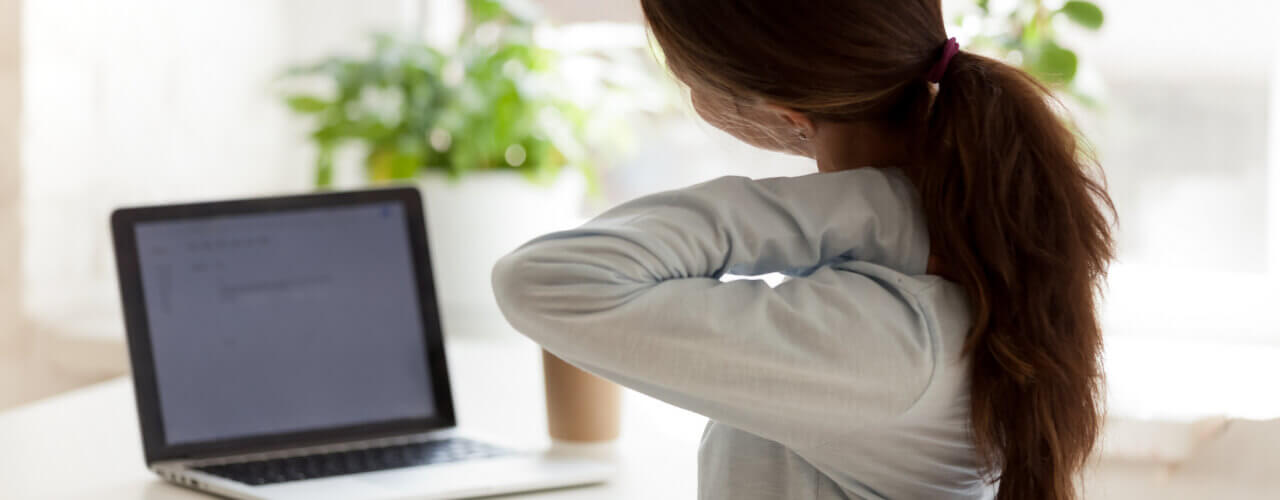Do you find that you’re always being told to sit up straight? Do you notice that you have shoulder pain after work? Are you developing a hunchback? If you’re nodding yes to these questions, chances are you have Upper Crossed Syndrome, or UCS. This is a muscle imbalance that occurs in the head and shoulders. It is often found in people who work desk jobs or sit with poor posture for most of the day.
As a result of this, they have weak cervical flexors and lower trapezius muscles (which form a straight line when looking from the side) and tight upper trapezius and pectoral muscles (forming the cross when looking from the side). Wow! That’s a lot of wires being crossed! UCS causes a person’s head to seemingly lean forward, their body to appear hunched, and their shoulders to ache often.
If you’ve been diagnosed with UCS, or notice any of the above symptoms, call TheraFit™ today to speak with a physical therapist about correcting the problem before it’s too late.
Symptoms of Upper Crossed Syndrome
People struggling with this condition normally appear stooped over with rounded shoulders. According to Healthline, this is because the deformed muscles put strain on the surrounding joints, bones, muscles and tendons. Below is a list of symptoms that accompany UCS:
- Headache
- Neck pain
- Weakness in the front of the neck
- Strain in the back of the neck
- Pain in the upper back and shoulders, as well as the lower back
- Tightness and pain in the chest
- Trouble with sitting to read or watch TV
- Trouble driving for long periods
- Pain and reduced movement in the ribs
How Can A Physical Therapist Treat Upper Crossed Syndrome?
Physical therapy is the best route to go when it comes to Upper Crossed Syndrome. Not only can a physical therapist relieve pain symptoms, but they can also eliminate underlying causes for your pain. You’d be surprised at what you don’t know about your body!
Your physical therapist can create a custom treatment plan that will address your pain levels as well as your symptoms. Typically, your physical therapy treatment plan will be divided into three parts - stretching the upper trapezius and pectoral muscles, strengthening the cervical flexors and lower trapezius muscles, and training you to make postural adjustments throughout the day to avoid future recurrence.
It seems like a lot, but don’t worry! That’s what your physical therapist is here for. Read on to learn more details about each part of this treatment method for UCS.
- Stretching - When it comes to Upper Crossed Syndrome, the first thing to focus on is restoring shortened muscles. When one muscle is tightened or shortened, the opposite muscle relaxes. Your physical therapist will recommend a series of stretches and other therapies, like myofascial release and massage, to lengthen the upper trapezius and pectoral muscles.
- Strengthening - Strengthening exercises in your physical therapy treatment will target the cervical flexors and lower trapezius muscles. The most basic stretch is one called the “chin tuck.” Your physical therapist will instruct you to lay on your back with your knees bent, without a pillow to support your head. Next, bring your chin as close to your neck as possible, while keeping the back of your head on the floor and your mouth closed. Keeping your head straight, hold this position for 10 seconds, 10 to 12 times. This is another exercise that you can do at home by yourself as well, so you can continue to make progress outside of your appointments!
- Postural Correction - You can do hours upon hours of stretching and strengthening exercises but it’ll be for nothing if you don’t address your posture! This is the problem that landed you with UCS in the first place. So, to address it, practice standing with your back and the back of your head against a wall. Your feet should be about six inches or so from the wall. Your neck should be two fingers-width from the wall. This is a fast and easy way to remind yourself what it feels like to stand up straight and have proper posture. Think of it as a way to retrain your body to know when it’s slouching.
You can also get a standing desk or adjust your own desk to be raised up a bit to allow for a more neutral posture sitting position. Pay attention to your posture as you text, type on a computer, cook in the kitchen, or drive.
Contact Our Office Today!
It’s easy for people to put off correcting something like their posture, because they’ve become so used to slouching or being hunched over. Putting off treatment will only make correcting the problem a longer process in the future!
Not only will you look better from a postural perspective, you will see bigger gains in your athletic performance. For more information about UCS or to find out more about the three part routine for correcting this issue, contact our physical therapy offices in Hazel Green, AL and Fayetteville, TN today. We’re ready and waiting for your call, and we can’t wait to see the improvements you’re bound to make in our care.

